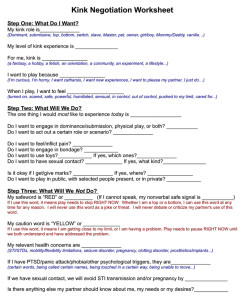One of the huge differences between kink and non-kinky sex is that the world of kink opens up many more possibilities for play. There are so many things that could be involved that it is impossible to get by with blanket permissions. For example, I can figure out that someone wants to have sex with me we’re working together to get naked and touching each other – but I can’t use body language to figure out if someone wants to do kinky things, and I can’t use body language to figure out which kinky things they like. At some point, you have to sit down and talk about what you do and don’t want to do. This can happen in one big conversation, or it can happen in a series of more casual exchanges, but it has to happen. You can’t wink and nudge at wanting to be tied to a chair and flogged!
 Many people who are new to BDSM have trouble planning what they want to do together. Planning a scene is a very individual thing. No one can tell you what to do here – but I can offer some guidance. Check out the kink negotiation worksheet.
Many people who are new to BDSM have trouble planning what they want to do together. Planning a scene is a very individual thing. No one can tell you what to do here – but I can offer some guidance. Check out the kink negotiation worksheet.
Start by establishing your goals. How does each participant want to feel? What roles does each participant want to take? What are you trying to accomplish here? Why do you want to play together? What activities do you have in mind? Reading erotica, watching porn, and reading check lists may help you gather ideas. Clarify whether you are negotiating a particular event or the relationship as a whole.
Use those goals to sketch out a scene and gain consent. What activities can each person agree to? What level of intensity is desired? What feelings are good, and which feelings are scene-enders? What types of physical and sexual contact are acceptable? This is also the time to talk about limits and things you do not want to do in this particular scene. Please take this step very seriously. You need to think about what scares you, because your partner isn’t a mind reader. If you don’t tell them that certain things bother you, they aren’t going to know and you could get pretty hurt.
Common limits include:
- blood
- disease transmission (aka unsafe sex)
- piss/shit (also called golden showers/water sports and brown showers/scat)
- feeling claustrophobic or feeling too exposed
- feeling worthless/humiliated
- feeling unsafe or being afraid of your partner (even in a play context)
- physical marks, physical marks in some places
- pain, certain types of pain, pain in certain places, pain past a certain level of intensity
- triggers – anything that reminds you of a past traumatic event
Think about what you don’t want to feel, and explain this to your partner in as much detail as you can. I don’t think it is okay for someone to pull an activity out of thin air and say “well, my partner didn’t say it was a limit!” but I also think it’s important to think about and talk as many limits as you can.
Go slowly. If you’ve never been spanked before, don’t start with 100 strokes. Plan for 10 strokes and see how it feels. You can always do more later, but you can’t take it back.
Communication is vital to safety, and it is necessary to make sure that your partner is consenting every step of the way. Always have a verbal and non verbal way to signal distress. Verbal ways include regular language like “no, stop it!” as well as safewords – be sure to discuss which you will use. I recommend that beginners use an easily remembered safe word, such as “red,” and also agree to listen to any normal language that implies distress (such as “wait,” “stop,” “no,” and “I’m calling the cops.”)
 Used with permission from http://apolloniasaintclair.tumblr.com/
Used with permission from http://apolloniasaintclair.tumblr.com/
Common non-verbal signals include:
- grunting
- snapping fingers
- dropping an object
- pressing a button to make noise
Agreeing upon a non-verbal signal is important any time that the bottom may be unable to speak clearly, such as when gags or loud music are used.
Communication also includes a discussion of body language. How do you act when you are distressed? Crying, shaking, tensing up, and flopping are all commons signs of distress where a sub might be too upset to think clearly and speak up. If anything like this happens it is vital that you check in and make sure your partner is okay. Checking in with each other is an important part of staying in tune, but it is necessary if your partner has body language that signals distress or panic. Bad body language should be treated like a safe word. Checking in can be as easy as saying “are you alright?” but if you don’t want to break character you can ask for a color, where red means stop everything, yellow means that you are on the edge and need to back up a bit, and green means that everything is fine and dandy. You may also ask your partner to rate the intensity they feel on a scale from 1-10. Agree on a maximum number before the scene begins.
When everything is going well you can also engage your partner by requiring them to actively participate in certain aspects of the scene – make them answer questions, repeat things back to you, get toys for you, etc. All of these interactions give the top a chance to gauge the bottom’s mental state.
The last thing you need is to cover basic health information. What barriers will be used for sexual contact (if any)? Does either participant have a health problem that might effect the scene? Let your partner know when you’ve had a bad week or are feeling down. Your mood has a huge effect on how you play. Discuss what aftercare you will need to stay physically and mentally healthy. Many people have a snack, cuddle, and talk after their scenes.
Experienced partners might not need to talk about everything every time they play, but it is good to revisit this discussion from time to time. If you already know each other well you might benefit from focusing the most on what activities excite you and what your current comfort levels are.
